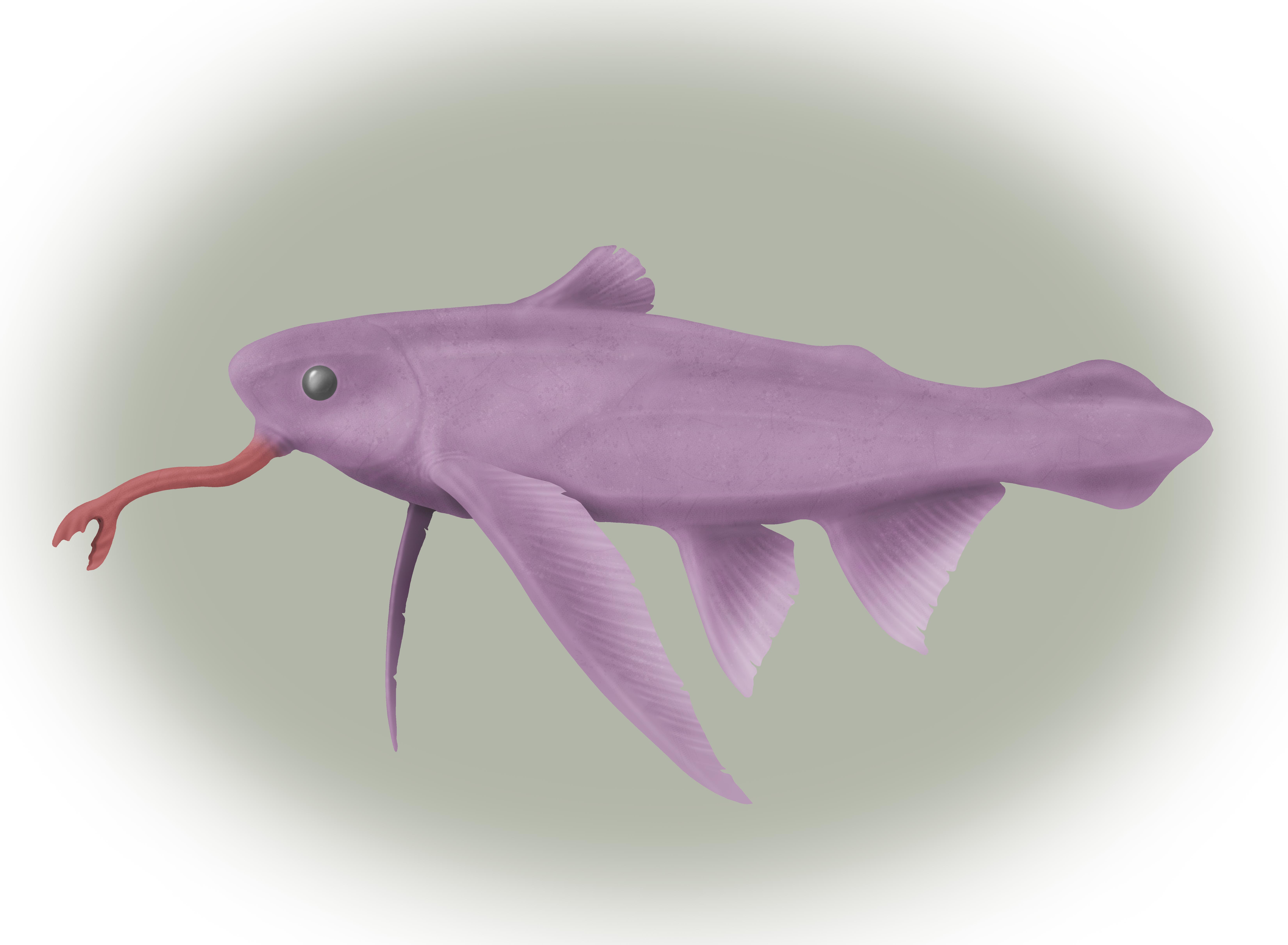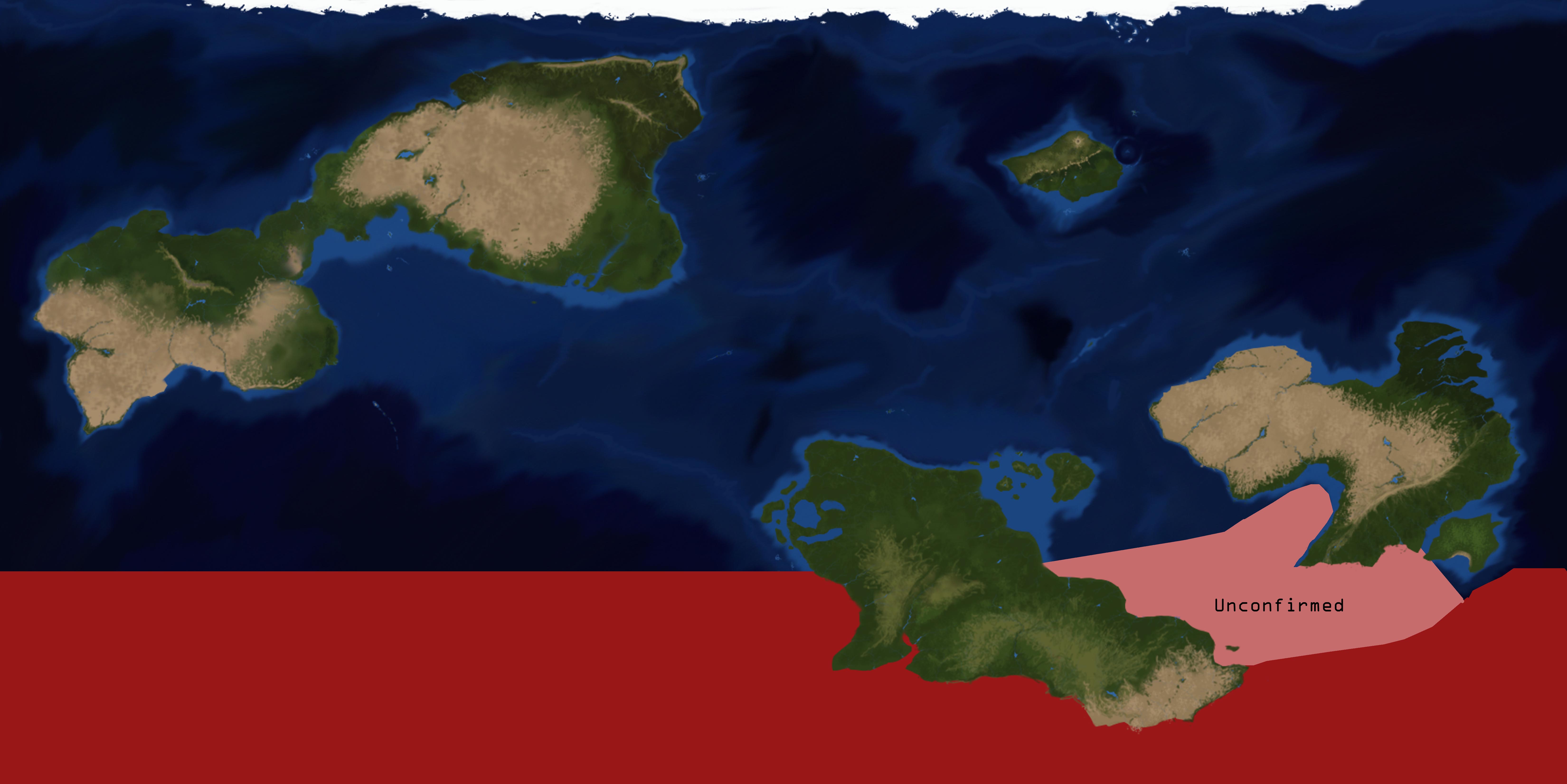Pink Nulù
Nulu abyssus is a species of Gymnocephalid Paleostomatosoid Ichthyomorph from the southern bathy- to abyssopelagic waters of the Nuwadi Ocean.
This Enetodontid, like many other more derived Gymnocephalids, sports a prehensile tuberculus and no mandibles, using the grappling end of the prolapsed esophagus to grab and hunt instead of their cousin's grabbing of the prey with the jaws and crushing tactic.
What makes the Nulù particularly interesting, however, is how the tuberculus is not retractable, a feature rarely found in Tubercolostomatosids as a whole and which can give us insights into what this animal's diet is like.
The inability to retract the tuberculus is consistent with animals that might feed on burrowing Abranchiates as the fixed structure makes the buccal area much stronger, able to sift through the seafloor while reducing the stress the appendage is under for the whole foraging period.
The other large hint that the fixed tuberculus gives marine biologists is that this animal is not an active hunter of any large animal species but otherwise relies on corpse falls that might come their way.
More flexible Tuberculi like the ones seen in the more active predators like Kugawas give the animal the ability to follow prey better and adapt to their evasive manoeuvrers, while a more fixed tuberculus wouldn't allow for this range of motion.
N. abyssus has only been observed living in the southern hemisphere and below depths of 1500 m.
Basic Information
Anatomy
- Elongated head; completely reabsorbed cranial armor.
- Tuberculus fixed in length ending in a grappling appendage.
- Pectoral fins large, pointing ventrally in rest position.
- Dorsal fin severely reduced, Dorsal II fin starting to evolve on the base of the Gill Fan.
- Anal I and II well developed with the second fin reminescent of more derived forms.
- Gill tail extremely short ending on a moderately sized Gill fan with average ridges and caudal drop.
Genetics and Reproduction
The species will mate in the spring.
How the mates are selected is not clear as they ascend to the surface to lay their eggs once mating already took place deeper in their natural habitats.
The eggs are laid in floating nests these animal crafts out of leaves and air bubbles kept together by a specialized mucus they produce.
After the first week of incubation, the nests will slowly start to sink; with the rising external pressure, the egg's surface begins to wrinkle and weaken, when deep enough this wrinkling of the egg will force the natal aculeus to break it, releasing the spawn from its sac.
This peculiar hatching technique is the result of the spawn inability to free itself from the egg as the outer membrane is naturally thicker than in other amphibians;
this mechanism also regulates at which depth the young are born putting them at the exact bathymetry needed for their survival.
The young will stay in the Epipelagic zone for a two to three weeks before submerging further and slowly making their way towards the adults.
Growth Rate & Stages
Nulù abyssus shows no signs of Ontogenesis during growth.
Specimens will reach sexual maturity sometime between three months and one year of age.
Loss of natal aculeus after the second week of life.
Ecology and Habitats
Bathy- to Abyssalpelagic animal found at depths comprised between 1500 m and 3000 m.
They are benthic animals that swim close to the seafloor looking for food, they seem to live in small groups of up to four specimens of mixed-sex.
Dietary Needs and Habits
Mostly predatorial feeding off of invertebrates and burrowing animals.
These animal play an important role in their ecosystem as they are scavengers that clean the ocean floor of falling corpses.
Biological Cycle
Not much is known on these animals however it is highly believed they enter long periods of hibernation during the winter when resources are scarce in the depths.
Additional Information
Social Structure
Social animal to an extent.
N. abyssus lives in small groups of up to four specimens of mixed gender; they have never been seen, however, interact between them other than the occasional spar for food.
Geographic Origin and Distribution
Depths of the Nuwadi Ocean to the Lizard's archipelago and the waters south of Outpost Island.
Some unconfirmed sightings in the Irobian Ocean.
Perception and Sensory Capabilities
Poor eyesight compensated by exceptional chemical receptors.
Symbiotic and Parasitic organisms
None known.
Scientific Name
Enetodontia; Enetodontida; Paleostomatosae; Gymnocephalidae ; Nulù; N. abyssus
Lifespan
Estimated at 6 years
Conservation Status
Data deficient: Not enough information on the species to properly assess its status
Population trend: UNKNOWN (Possibly declining)
Average Weight
10 to 200 gr
Body Tint, Colouring and Marking
Completely pink to purple body with red tuberculus.
Remove these ads. Join the Worldbuilders Guild












Comments